
Pain is an important clinical symptom. which usually signifies that
something is wrong, e.g. tissue damage or disease. Pain is also one of
the classical components of inflammation. Often, the pattern and presentation
of the pain can be sufficiently characteristic to provide a diagnosis,
but sometimes the origin of the pain can be misleading - as in referred
pain.

At its simplest level, pain appears to be like other sensations, and
is mediated by its own neural pathway of specific receptors, afferent nerves,
CNS relays and ascending projections, etc. But in reality, pain is very
complex and can be affected by numerous factors, as shown in this graphic.
There are several distinct types of nociceptors:
(a) A 'specific' pathway, probably the spinothalamic tracts, which projects to the somatosensory cortex. This pathway probably serves the 'sensory' and 'discriminative' aspects of pain.
(b) A 'non-specific' pathway, probably involving the spinoreticulothalamic tracts, which makes widespread and diffuse connections with many areas of the forebrain, including the limbic system. This system may serve the affective (or 'nasty') aspects of pain.
The basic concept is that signals elicited in afferent neurons by noxious stimuli can be blocked or filtered by a synaptic 'gate' in the dorsal horn of the spinal cord. The story is complex and there are many controversial features. However, the principle does seem to work in practice. even if the precise mechanisms are unsettled.
The 'gate' is believed to be located in the substantia gelatinosa (SG)
of the dorsal horn.
Neurons of the SG make connections with the terminals of primary afferent
fibres and also the dendrites of dorsal horn cells. Through either pre-synaptic
or postsynaptic inhibition, the substantia gelatinosa neurons appear to
be able to block (or reduce) activation of second order neurons by nociceptive
inputs; these 'gating' effects of the SG neurons can be activated by:
(a) inputs in large diameter (A) afferents innervating the injured area. (This provides the basis for pain relief by selective activation of large diameter afferents, as in transcutaneous electrical nerve stimulation - TENS).
(b) activation of neurons in certain brainstem regions, which
send axons to the spinal cord.
The central effects of opium and narcotic analgesic drugs like morphine have been known for a very long time, but it is only recently that techniques have become available to investigate their mechanisms of action. The CNS is known to contain several different types of opiate receptors. These are acted upon by a number of naturally occurring opioid peptide transmitters, such as enkephalins and endorphins.
The precise mode of action of these opioids in analgesia is uncertain,
but they are present in areas such as the PAGM and dorsal horn (substantia
gelatinosa) and are likely to be implicated in the neural basis of gate
control.

In overall adaptive terms, it seems that the endogenous analgesia system
can be activated as part of a generalized neuro-endocrine response to stress.
Here, the stress is physical; indeed, many forms of physical activity
e.g. exercise, and pleasurable activities such as eating, drinking and
sexual behaviour, are known to cause the release of opioid peptides.
One aspect of this stress response is the familiar 'fight or flight'
reaction involving increased sympathetic discharge and release of adrenal
hormones (both medullary catecholamines and the glucocorticoids). In an
animal thus prepared for 'fight or flight', there is perhaps added survival
value in simultaneously being able to 'switch off' pain.